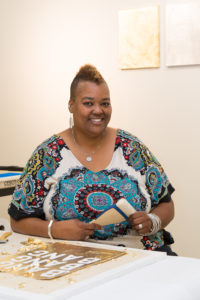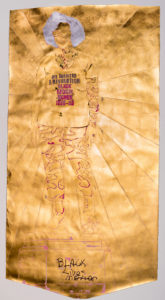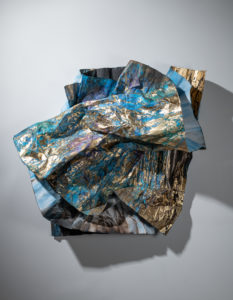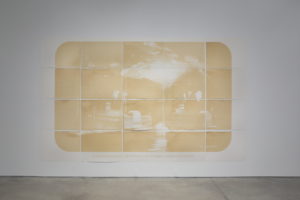For the past several years during March – Women’s History Month – The National Museum of Women in the Arts has been asking the question: Can you name 5 women artists? The campaign calls attention to the fact that women remain underrepresented in museums, galleries, and auction houses. The Gibbes will participate in this initiative by featuring several women artists in our collection here on the blog throughout the month!
This week on the blog, Stacy Lynn Waddell shares some of the influences that have shaped her career, and insights into her artistic process. With a variety of transformative processes that include heat/laser technology, accumulation, embossing/debossing, interference and gilding, Waddell creates works that structure sites of intersection between both real and imagined aspects of history and culture. These points of intersection, pose important questions related to authorship, beauty and the persuasive power of nationalistic ideology.
1. What woman in your life has been influential in your career as an artist?
It would firstly have to be my Mother. My Mother grew up in a farming family, but had a variety
of unusual opportunities as a young woman that expanded her social and cultural awareness. She has always understood the value of cultural production and continues to support me in that regard. This type of early support and permission was incredibly empowering.

2. What advice would you give to women who are pursuing a career in the arts?
Truthfully, I don’t like to give advice, especially to artists. The discipline depends upon so many variables that the best advice comes out of your own lived experience in it. However, since you’ve asked, I’d offer this: Be aware of history, but then forget about it altogether. Be diligent about giving yourself the permission to guard your time in the studio and during your research. Never make excuses or apologize for having a keen focus and work ethic because this is required of serious practitioners of ANY discipline. Make sure to love yourself as you develop and nurture your work as the journey – although filled with joy, beauty and successes – can and will be relentless.

3. If you could meet one female artist, living or deceased, who would that be, and why?
This is a near impossible question to answer! There are both living and deceased female artists that mean a great deal to me: Beverly Buchanan, Howardena Pindell, Lynda Benglis, Dawn Clements among a few others. For some time, Kiki Smith has been of particular interest not so much for what she makes, but for HOW she navigates the expansive material languages that she utilizes. I admire her longtime relationship with print shops and foundries as they ensure that collaboration remains central to her process. That she has stationed her base of operations out of her home and considers the domestic a place of insight and possibility is also an enduring inspiration.

4. Do you have one specific work that you’ve created that has special significance to you, more so than others?
In 2015, I was afforded the opportunity to make an expansive, unique state print using laser
technology. This project combined my love of paper, unusual printmaking techniques and trial
and error. Although this wasn’t a traditional printmaking studio, my working relationship was
much like that of an artist working with a Master Printer. Here, I appropriated a lithograph published in 1860 by Currier & Ives entitled A Midnight Race on the Mississippi. I tweaked the image in Photoshop and enlarged it requiring that we print it on twenty sheets at an overall dimension of 88 x 150 inches. The resulting image entitled, A Midnight Race Between A Butterfly And An Eclipse (2015), brings to mind a vintage sepia photograph. This collaboration was a seminal moment that I have dreamt of duplicating ever since.

5. What has been your biggest challenge as a woman in the arts?
I am not sure if my challenges can be specifically attributed to my being a woman. Early on, my decisions didn’t exactly make a beeline to the art world. I worked as a high school teacher for a number of years until deciding to earn my MFA when I was 40 years old. After graduation, instead of heading towards a city more central to the contemporary art conversations, I made the practical decision to stay here in North Carolina. Overall, my biggest challenge has been an overwhelming sense of regionalism that can be helpful at the very beginning of your career, but that type casts you just as you begin to take next steps as an artist. Even in an age where you can seemingly “exist” anywhere – geography still comes into play when people assess the work.
-By Stacy Lynn Waddell, guest blogger
-Published March 15, 2019
-Top image: Stacy Lynn Waddell at the Gibbes Museum with her work, Manifest.

